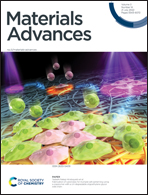Tetra-coordinated boron-appended zinc(ii)-salen: a highly selective fluorescence-based sensor for Sm3+ ions via sensitization†
Abstract
Selective detection of metal ions is very important from the environmental and biological points of view. In this regard, selective discrimination between lanthanide ions is very difficult and challenging owing to their similar atomic radii. Herein, we report a tetra-coordinated boron-based salen ligand that shows selective fluorescence enhancement with Zn2+ ions. More interestingly, isolated zinc complex 6a was able to detect Sm3+ ions selectively. The luminescence color of complex 6a changed from green to red upon addition of Sm3+ ions, which makes this design highly selective in discriminating Sm3+ ions in the presence of other lanthanide ions at a very low concentration of 1 × 10−5 M.



 Please wait while we load your content...
Please wait while we load your content...